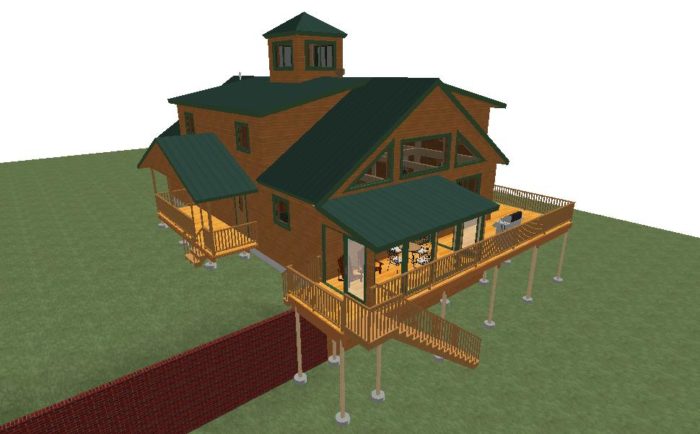
Dealing with a SIP roof:
A building project in northern Vermont will include a structural insulated panel (SIP) roof, but sealing potential air leaks may be difficult.UPDATED on July 7, 2011 with comments from Tedd Benson
Jay Hersh is building a house in northern Vermont that will have a roof of structural insulated panels. Although his plans are fairly advanced, Hersh is still stumped about detailing the SIP seams to prevent the migration of moisture-laden air from inside to outside. He’s also looking for a foolproof way of heading off any leaks from the outside.
This strategy, as he explains in this Q&A post at GreenBuildingAdvisor, involves the installation of a membrane (as yet unidentified) between the tongue-and-groove ceiling and the roof SIPs, and another membrane between the top of the SIPs and the standing-seam metal roof.
Suggestions to date for the roof underlayment on top of the SIPs include asphalt felt, RoofTopguard, or Grace Ice & Water Shield. He’s not sure what type of membrane to use between the ceiling boards and the SIPs.
Hersh asks for advice, and the resulting discussion is the subject for this week’s Q&A Spotlight.
Air infiltration can be a problem
SIPs consist of an inner core of foam and two outer faces of oriented strand board (OSB). While the assembly can perform well, writes Albert Rooks, it’s also “extremely sensitive” to moisture in seams where the panels meet.
Rooks seconds GBA senior editor Martin Holladay’s suggestion that the most important step is a good air barrier, including spray foam at all SIP seams plus a high-quality tape on the interior at all seams.
Moisture problems can still develop over the life of the roof in three ways, Rooks adds:
Weekly Newsletter
Get building science and energy efficiency advice, plus special offers, in your inbox.

This article is only available to GBA Prime Members
Sign up for a free trial and get instant access to this article as well as GBA’s complete library of premium articles and construction details.
Start Free TrialAlready a member? Log in





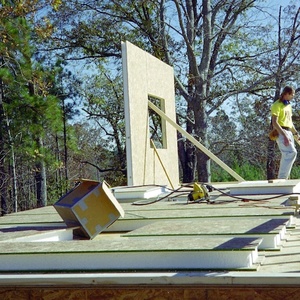
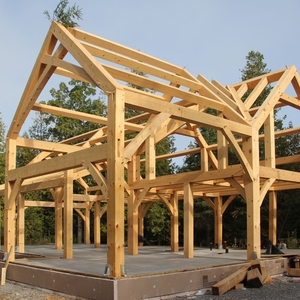
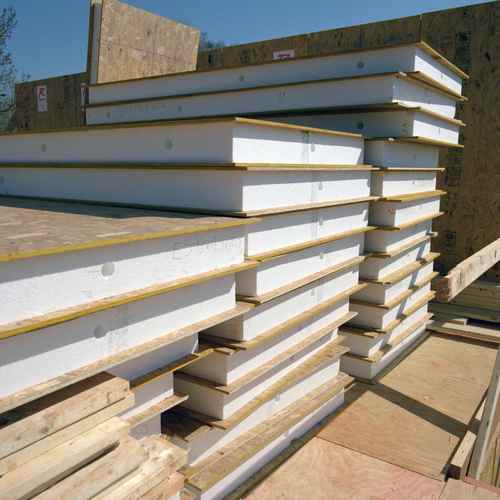
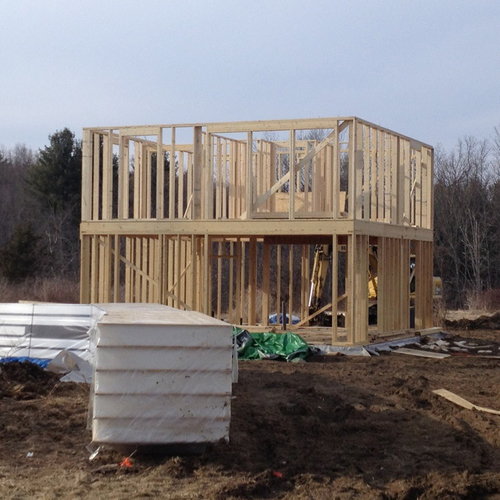






23 Comments
Oh my.
To extend Brett's thinking: "cathedral roofs and t&g ceilings - why the hell do people do these?".
Sorry to be blunt, but this whole situation arises from pursuing the appearance of a natural home while ignoring the actualities. The net result: chopped up bits of wood stuck to a too-high ceiling to conceal half an inch of flakeboard and eight inches of petrochemical foam. It's a combination that usually falls more on the side of conspicuous consumption and impressing the neighbors than any green building reality.
First principles: boarded ceilings are inherently leaky. Vaulted roofs are inherently wasteful of materials and energy. Deployed together they almost always result in a significant energy penalty, not just thermally but also in a darker than necessary interior where artificial lighting will regularly be used even in the daytime. This is how they generally end up dotted with countless can lights mounted far too high to provide good illumination. Standard 'solution': add more cans. Lighting design 101: effective illuminance on a surface falls off in proportion to the SQUARE of the distance from the light source, people!
OK. Rant over. I feel better.
for James Morgan
As a consumer, it was conversations such as these that have lead my plans away from just such a design. It sounds so simple when you say it: "Plunk some SIPs over the timber frame and you're done." Such conversations serve as a powerful reminder of just why such structures are a contradiction of where my comfort level leads me. I feel bad for Jay Hersh, but the discussion continues to be invaluable for those of us who are listening.
Joe W
How to install SIPS over a T&G ceiling
OK, we do this all the time, mostly in retro-fit situations, but it is really quite simple. Do not use SIPS, use Nail-Base Panels (Insul-lam is a local brand name for them). The Nail-Base product is like a SIPS panel with foam on only one side. We prefer to have them shipped with 5 1/4" of foam on the OSB, and a second layer of 4" foam to install underneath, with seams staggered between the two layers. This makes for a total foam thickness of 9 1/4", which allows a standard 2x10 to be used for sealing up the gable ends, and a 2x12 ripped to the appropriate angle will work for the eaves. The panles are available in larger sizes, but for this application, 4'x8' panels are the least costly, and will work just fine.
Now for the installation part: The type of spray-foam that comes in a can is not a very good air barrier, but it does provide good insulation value. The proprietary caulk-type sealants that the SIPS manufacturers sell is an excellent air barrier, but it does not fully eliminate any air gap that may exist between panels. The solution is to use both. At the bottom corner of each panel, place a 3/8" bead of the caulk, then at the center line of each panel use a bead of spray-foam. Squish the panels tightly together, once you have about four of the 4" foam panels down you can start with the top layer, and repeat the same process. You will have a total of four beads of protective material, two of the caulk, and two of the foam, which should have spread out to completely fill any gaps between the panels.
For the top membrane, use GAF DeckArmor, it is a vapor-permeable roofing underlayment, that will allow any moisture that does make it through to escape out the top as vapor on any warm day.
We usually start the foam panels over a layer of 30 lb felt, just because we are usually doing this as a retro-fit, and that is what is already there. Just about any underlayment would work. Most roofing underlayments are NOT vapor permeable, so something like Matrix, or any of the other synthetic underlayments would work well.
Regarding James Morgan's rant...
James is right, if you allow the T & G decking to lay across the exterior walls all the way out the overhangs. On the other hand, if you stop the T & G at the middle of the wall line, then install a 2x2 or 2x4 parallel to the wall line, properly air-sealing the perimeter, then commence with separate runs of material on the outside, you will not have the horrendous air infiltration problems that many homes of the 1960s and 70s had with this type of ceiling layup.
As for cathedral ceilings, we use them in almost every home we build, and we are going WAY below net-zero-energy, even in cold climate zones. It is all in the details, my friend! No recessed cans, of course, but pendants on tracks are very nice, getting the light down where it will do you some good.
Joe W, have heart, we can build you the home you want, with all the style points you desire, and still make it darned energy efficient. Would you like to power your electric car with the surplus power produced by your home? We do that...
How does one know if the roof panels are deteriorating?
Oh My - I have SIPS roof panels and walls, and ICF basement. Our home is only 6 years old. How would we know if the contractor did everything right, or if the panels already have moisture damage. Esp concerned about the roof - which is the ceiling for the third floor rooms. There are large exposed beams with panels in-between.
Are their tell tale signs, or do they have a life span? Do I lay awake at night now and stare up and wonder if moisture is doing its damage?
How to install SIPs over a T&G ceiling - retrofit
I agree with Ted's comments. I've not done this as frequently as he may have, but I installed about 32 square of 4'x8'x10-1/2"nailbase insulation panels (SIPs w/o the bottom facing OSB) over 1/2" OSB over 2 layers of 1-1/2" polyisocyanurate insulation over GAF WeatherWatch underlayment over a 38 year old (now 40) 2x6 T&G #2 Fir roof deck on my own A-Frame. 30 lb felt underlayment was installed over the top layer of 3/4" OSB prior to installation of the standing seam roofing.
We foamed the joints and caulked the splines of the nailbase after staggering the joints of the two 1-1/2" polyisocyanurate layers foaming as/where needed. The 2 layers of high-R insulation board were used to encapsulate electrical wiring in 1/2" conduit and low-voltage wiring run on the roof deck as well as the 3" OD insulated 1" copper supply/return tubing run on the roof deck for the seven 4'x8' solar hot water panels mounted just below the ridge. The interim layer of 1/2" OSB was primarily added to protect the bottom layers while the nailbase was installed and to aid installation of the 15" screws securing the panels to the deck. (In hindsight that layer might have been better to be 3/4" treated ply so the screws could have provided less of a thermal bridge, but I was also concerned about secure attachment.)
In 2009 I may not have been familiar w/ GBA, but this was the favored solution for all of the issues I identified according to all the building science folks consulted. The roofing is 24 gauge steel with a Kynar finish which should last 75 years or more on this 24/12 pitch. Feel free to check back with me in 25-50 years to see how the solution is performing.
Response to Karla
Karla,
Don't freak out if you don't have any signs of problems.
What's your climate? Most SIP problems have occurred in cool, damp climates. There was a big cluster of failures in Juneau, Alaska.
The first signs of problems with the roofs in Juneau occurred when workers walking on the roof noticed soft spots. On some homes, mushrooms were actually growing on the roofs, pushing through the asphalt shingles. The mushrooms grow in stripes, right above the SIP seams.
How to protect SIPS from decay....
A much too common problem with some SIPS--usually panels made out of square;panels not installed square on site; using DIY foam in a can...
Suggestion: Get in touch with Jeff Brooks-sales manager with Vermont Timber Frames/ Timberline Panel Co.,LLC- at : [email protected] (Cambridge NY/ Bennington VT)
VTF started making their own panels in their own production facility---EPS with OSB in panels up to 8" x 24' (2 sheets OSB at 8 x 24 w/ 2 sheets 4 x 24 foam); custom in-house cutting; installation offered; lifetime warranty on the panels; they also make panels with BASF's Neopor foam- the graphite coated EPS= +/- R-value about 20% higher than plain EPS. Timberline/VTF have seen all kinds of problems with other makers panels; they trouble shoot all the time with situations with hybrid (panel-to-frame) situations; they also make nailbase panels; also sign up and join SIPA-Structural Insulated Panel Association- as a builder member. SIPA wants panels installed and used correctly-a GREAT resource!!!!
These are not the panels from the late 70's, early 80's--panels done correctly have a great future in our profession whether it's for a timber frame skin; a Passivhaus; a SIPS house; or nailbase panels for a deep energy retrofit....remember...time is money... and money is a resource as well.
Failed panels from Alaska
I was at a SIPS plant in Fife when a load of the failed panels from Alaska was being unloaded off a truck to be examined as to the cause of failure. They had removed the panels by cutting down the centers of the panels, leaving the seams exactly as they had been installed. There were gaps at least 1/4" wide, with no attempt made to install any adhesive, sealant or spray foam of any kind in any of the joints. This was clearly an installation failure, by workers who had no clue what they were doing. The approved installation method requires at least four sealant locations (including the SIPS tape on the inside), NONE of which were even attempted on the failed panels.
Karla, if your home was constructed by an experienced SIPS installer, you can sleep very well, you will not have any problems with your SIPS roof.
I don't get it
If the author knows that controlling vapor is going to be an issue, why would he propose a detail like T&G material regardless of the assembly. So the SIP shows up the bad design in a more dramatic fashion than a foam/BIB/Batt truss? The rest of the commentary seems silly, SIPs are an engineered wall and ceiling assembly that come with detailed installation requirements. The fact that the construction industry routinely screws up the installation of even the most basic of assemblies, comes as no surprise to anyone.
Response to Michael Anschel
Michael,
I'm not sure I understand your point. You wrote, "If the author knows that controlling vapor is going to be an issue..." But the discussion on this page is about air leakage, not vapor control. No one worries about vapor diffusion through SIPs. Moreover, OSB rot at SIP seams is always due to air movement, not vapor diffusion.
SIP's as the environmentally friendly option
From our perspective SIP's panells are a great choice when considering green option. The EPS foam core although made from pertochemicals is actually 98% air. In addition using the pre cut panels reduces construction waste dramatically. Interestingly the Insulspan plant where we source our panels has measured their waste and has determiuned that less than 7% of the raw material goes as waste. They then chipp waste EPS and sell it for use in other products. Waste OSB panels are also resold.
Response to Bob Deeks
We've slowed our use of SIPs in the last decade because of our inability to effectively recycle the waste cutoffs. For the most part, we now limit our use of SIPs to roofs because there is much less waste, and we're able to reuse the large size cutoffs more easily. With the many window and door openings, as well as the roof angle cutoffs in the wall panels, there is an enormous amount of waste that is extremely hard to recycle because the skins have to be separated from the foam cores, which is very hard to do. Also, even when that laborious skin-separation job is done (ripping in to manageable widths, then slicing with a bandsaw), foam residue is inevitably left on the inner face of the skins, making those pieces difficult to recycle or grind up for heating fuel. It's good that we don't bring waste to the jobsite, having precut the panels in our facilities, but it's not so good if the result is filling up our local landfill.
Therefore, though we have used SIPs for many years, I think we have to be careful about gracing them with the green label. They are quite good at insulating, but I don't think the huge amount of waste that typically results from the cutting and shaping of wall panels has really been solved, and therefore it's system that I've come to think just isn't green enough. That's an opinion I regret to say because I've advocated for SIPs use as much as anyone in the past. I can even hold on to the argument that using petrochemicals for insulation isn't such a bad thing; in fact, it may be one of the least bad things to do with that precious resource. But I can no longer condone the usual volume of waste generated from the construction of a single residential building. We have to do better.
We HAVE done better using SIPS
We have designed and built SIPS buildings with absolutely zero waste. By designing window opening sizes to correspond to sizes of panels needed to fill in above doors and below other windows, we have been able to use every scrap of material ordered. About five years ago we built a 5,000 sf commercial building this way. We saved thousands of dollars of fabrications costs by doing it ourselves on-site. SIPS efficiency is all in the design. We also recently built a home with only nine studs in the walls, not counting the outside corners. When done right, SIPS are without a doubt the most green way to build.
To a man with a hammer
everything looks like a nail. SIPS may have their place and their purpose in the green building toolkit but nonsensical claims like "without a doubt the most green way to build" do the product no service. Ted's lead point is a fair one, that through focusing design entirely on the characteristics of the material SIP waste can be minimized - even eliminated. But compromising other essential design criteria in order to make up for the lack of flexibility of a particular material's form factor is no way to pursue the best in green construction.
Sacrificing other design criteria?
Nobody sacrificed anything. Let me give you an example. For our commercial building, we used 3'x5' windows, in a 13' high wall. The story height was predicated by the intended use of the building. If you subtract the 5' window height from the 13' wall height, you get 8', the standard width of a SIPS panel. An 8'x12' panel will net you four panels for below windows, and four panels for above windows, zero waste. Gable end walls were calculated to use the cut-off from one panel to form the next. As long as your building width is on a 4' multiple (or even on a 2' multiple, since you have two ends to work with, and a 4' minimum stock panel width), you can easily design to use every piece of panel. We have way too many tricks to enumerate here, but I want to stress that we design for building and room function first, then for passive solar, then for net-zero-energy, then for materials efficiency. If you close your eyes to the possibilities, you will never see them!
One last note on recycling SIPS, a hot-wire cutter will remove the foam from the OSB, even on a full 8'x24' panel, with very little foam left on the OSB. The scraps of foam from on-site cutting can be bagged up, and added to attic insulation. It takes about eight large garbage bags, loosely filled with EPS foam scraps, shipping peanuts, and other waste foam to surround an attic access hatch. This way the loose-fill attic insulation will be less likely to find its way through the attic opening each time you open it. We often ask for the triangular eave rips to be sent along with our order. When our roof lands on a second floor, we can caulk up the triangles, and stuff (and nail) them into the angled joint between floor and roof. Net-zero-energy, net-zero-waste. Everybody wins, no compromises!
Good comeback, Ted.
Sorry for jumping to conclusions on your design priorities. Goes to show that any material is as good as you choose to make it.
Bagged foam scraps as insulation??
Ted comments above that he bags scraps of foam to use as attic insulation around access hatches, etc. I used to think that was a good idea, but then realized that the air circulation within the bag around the scraps would likely negate a lot of the insulation value. I have been known to 'glue' scraps together with spray foam, but that generally isn't practical.
My current project is a great room timber-framed with SIPs, which is what got me reading this in the first place.
Bagged foam scraps
Terry's point above would probably apply to large scraps, with a lot of air, but we are using a combination of packing peanuts and sweepings from the SIPS job site, which pack in about as tight as any loose fill insulation. Because the air inside the bag cannot be "air-washed" by breezes blowing through the attic, it would be much less prone to losing energy than the rest of the attic insulation. Interesting point, though, I'll have to take some infra-red pictures next time I have someone with an infra-red camera at one of our job sites. It will be interesting to see what it shows!
IR pics of bagged scraps
I would be very interested in 'seeing' how these work out.... I have been 'collecting' foam scraps and would really like to have an effective use for them!
Building with SIPs
Just reviewed all the interesting comments. I'm a never ending do it yourself-er. Am also a certified draftsman living in the greater Phoenix valley of the sun. I have plans to build a retirement home outside of Globe, Arizona an old mining town. my property is located a 5,000 ft altitude on a rocky mountain side. It's dry and hot most of the year except during a month long summer monsoon of blowing rain and a short few weeks of winter snow. I plan to build a post & beam straw bale house with a SIP roof, metal standing seams. I also plan for a few other SIP wall panels where bales are not flexible, like under window seats, and a clerestory section on the roof peak to gain ventilation. Obviously, my weather conditions and building materials are different than discussed. Did I mention I'll be using earthen plaster on the wall and adobe brick for a heat sink. Of course the cardinal rule of straw bale building is the bales must never get wet. Are SIPS suitable for me and my climate conditions?
Response to Steven
Steven,
As long as you do a conscientious job of installation, with attention to air sealing and water management details, I think SIPs will perform well for you.
Not just a SIP problem
Moisture issues are not limited to SIPs, but in my opinion are limited BY SIPs. SIPs are big pieces leading to fewer joints that need to be sealed. Other systems have far more joints to worry about.
I build with SIPs and with spray foam in existing buildings. I seal sip joints with spray foam, and an interior tape on all my SIP panel joints. I certainly could have a problem with an imperfect SIP joint some day, but to date the only issue I have had has been with a stick framed roof insulated with spray foam. The spray foam left some small (pencil sized voids) near the peak, leading to condensation/staining on the plaster ceiling. The spray foam installer was very conscientious, but getting a "perfect" continuous air seal is difficult. The rafters may have shrunk or twisted enough to open up a path for air (the project is 10 years old). The house has a very high indoor moisture content which aggravated the problem. The SIP portion of the house has no moisture issue however. In this case the SIPs remained sealed and resisted the moisture problem on the same house. I am not advocating one system over the other, just saying that moisture problems aren't specific to any single building method.
Log in or become a member to post a comment.
Sign up Log in